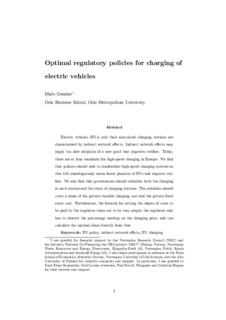| dc.contributor.author | Greaker, Mads | |
| dc.date.accessioned | 2020-10-30T10:39:28Z | |
| dc.date.accessioned | 2021-04-29T11:26:35Z | |
| dc.date.available | 2020-10-30T10:39:28Z | |
| dc.date.available | 2021-04-29T11:26:35Z | |
| dc.date.issued | 2020-10-30 | |
| dc.identifier.uri | https://hdl.handle.net/20.500.12199/6421 | |
| dc.description.abstract | Electric vehicles (EVs) and their associated charging stations are characterized by indirect network effects. Indirect network effects may imply too slow adoption of a new good that improves welfare. Today, there are at four standards for high-speed charging in Europe. We Önd that policies should seek to standardize high-speed charging systems as this will unambiguously mean faster phase-in of EVs and improve welfare. We also Önd that governments should subsidize both the charging at each station and the entry of charging stations. The subsidies should cover a share of the private variable charging cost and the private Öxed entry cost. Furthermore, the formula for setting the shares of costs to be paid by the regulator turns out to be very simple; the regulator only has to observe the percentage markup on the charging price, and can calculate the optimal share directly from that. | |
| dc.language.iso | nb | en |
| dc.publisher | Oslo Business School, Oslo Metropolitan University | |
| dc.relation.ispartofseries | Working Paper;2/2020 | |
| dc.subject | EV policy | |
| dc.subject | Indirect network effects | |
| dc.subject | EV charging | |
| dc.title | Optimal regulatory policies for charging of electric vehicles | |
| dc.type | Working paper | |
